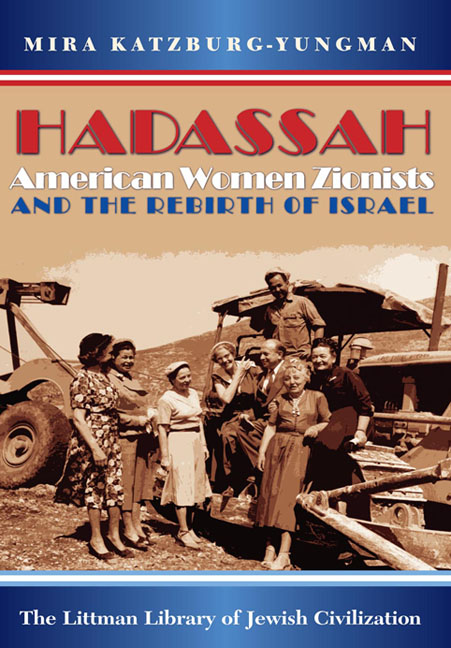Book contents
- Frontmatter
- Dedication
- Preface and Acknowledgements
- Contents
- List of Plates
- Note on Transliteration
- Prologue
- PART I CONTEXTS AND CHALLENGES
- PART II THE AMERICAN SCENE: IDEOLOGY AND PRACTICE
- PART III THE WORLD ZIONIST ORGANIZATION SCENE
- PART IV THE ISRAELI SCENE: HADASSAH AND THE NEW STATE
- 8 Hadassah in the War of Independence, 1947–1949
- 9 A Young State with Many Needs
- 10 Welfare and Education Projects for Children and Teenagers
- 11 Projects for Immigrant Children and Teenagers
- PART V HADASSAH IN CONTEXT
- APPENDICES
- Bibliography
- Plate Acknowledgements
- Index
8 - Hadassah in the War of Independence, 1947–1949
from PART IV - THE ISRAELI SCENE: HADASSAH AND THE NEW STATE
- Frontmatter
- Dedication
- Preface and Acknowledgements
- Contents
- List of Plates
- Note on Transliteration
- Prologue
- PART I CONTEXTS AND CHALLENGES
- PART II THE AMERICAN SCENE: IDEOLOGY AND PRACTICE
- PART III THE WORLD ZIONIST ORGANIZATION SCENE
- PART IV THE ISRAELI SCENE: HADASSAH AND THE NEW STATE
- 8 Hadassah in the War of Independence, 1947–1949
- 9 A Young State with Many Needs
- 10 Welfare and Education Projects for Children and Teenagers
- 11 Projects for Immigrant Children and Teenagers
- PART V HADASSAH IN CONTEXT
- APPENDICES
- Bibliography
- Plate Acknowledgements
- Index
Summary
ISRAEL'S WAR OF INDEPENDENCE began on 30 November 1947, the day after the UN resolution to divide Palestine into a Jewish state and an Arab state. It ended with the signing of the last ceasefire agreement, with Syria, on 20 April 1949. The war can be divided into two major periods: from 30 November 1947 until the end of the British Mandate on 15 May 1948 (the day after the Jewish state was officially declared); and from the next day until the end of the war.
The war began as ‘“riots”, which quickly developed into the conflagration of battles’. In the first period, Arab gangs assisted by volunteers from neighbouring countries attacked essential transportation routes, concentrations of Jews in mixed (Jewish and Arab) cities, and isolated settlements. At this stage resistance was mounted by underground organizations of the Yishuv, particularly the Haganah. When the British left, the regular armies of Egypt, Transjordan, Syria, Iraq, and Lebanon, as well as volunteer units from Saudi Arabia, Libya, and Yemen invaded, with the aim of destroying the State of Israel in its infancy. They were met by Israel's army, known since 30 May 1948 as the Israel Defence Forces (IDF).
Over the whole period of the war some 6,000 Jews died, from a total Jewish population of 650,000.
REQUESTS FOR HEALTH FUNDING
At the Twenty-Second Zionist Congress, which convened in Basel in December 1946, David Ben-Gurion, already heading the Zionist Executive, assumed responsibility for the ‘security portfolio’ of the Yishuv. By that point the Zionist leadership had already reached the conclusion that when British forces left Palestine the Arab armies would invade, with the aim of taking control of the entire territory; and so, from then on, Ben-Gurion laboured constantly to assess and deal with the defence problems of the state-in-the-making. The urgency of the task could not have been greater. As noted above, the very day after the UN approval of partition the Arabs began their assault. Among other incidents, the attack on the Hatikva neighbourhood of southern Tel Aviv and the murder of Jewish workers at the Haifa oil refineries in the first month of the war were grim harbingers of what was to come. The attacks spread across the country and casualties mounted rapidly: in the first two weeks of the war, ninety-four Jews were killed and one hundred wounded.
- Type
- Chapter
- Information
- HadassahAmerican Women Zionists and the Rebirth of Israel, pp. 159 - 173Publisher: Liverpool University PressPrint publication year: 2011



